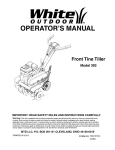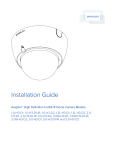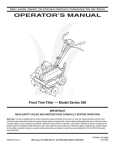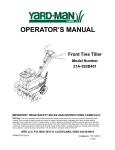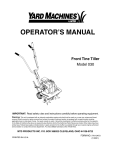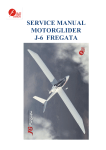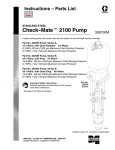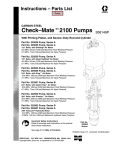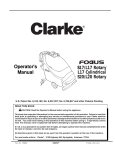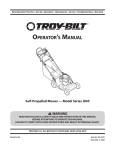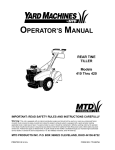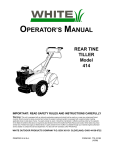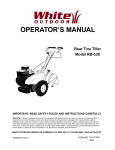Download Yard Machines 390 Tiller User Manual
Transcript
Operator’s Manual Front Tine Tillers Models 340 Thru 390 Model 390 Shown IMPORTANT: Read safety rules and instructions carefully before operating equipment. Warning: This unit is equipped with an internal combustion engine and should not be used on or near any unimproved forestcovered, brush-covered or grass-covered land unless the engine’s exhaust system is equipped with a spark arrester meeting applicable local or state laws (if any). If a spark arrester is used, it should be maintained in effective working order by the operator. In the State of California the above is required by law (Section 4442 of the California Public Resources Code). Other states may have similar laws. Federal laws apply on federal lands. A spark arrester for the muffler is available through your nearest engine authorized service dealer or contact the service department, P.O. Box 368022 Cleveland, Ohio 44136-9722. MTD PRODUCTS INC. P.O. BOX 368022 CLEVELAND, OHIO 44136-9722 PRINTED IN U.S.A. FORM NO. 770-10135A.fm (9/99) TABLE OF CONTENTS Content Page Important Safe Operation Practices................................................................... 3, 4 Assembling Your Tiller....................................................................................... 5 Know Your Tiller................................................................................................. 7 Operating Your Tiller.......................................................................................... 8 Making Adjustments .......................................................................................... 12 Maintaining Your Tiller ....................................................................................... 13 Off-Season Storage ........................................................................................... 14 Troubleshooting ................................................................................................. 15 Parts List............................................................................................................ 16 FINDING MODEL NUMBER This Operator’s Manual is an important part of your new tiller. It will help you assemble, prepare and maintain the unit for best performance. Please read and understand what it says. Before you start assembling your new equipment, please locate the model plate on the equipment and copy the information from it in the space provided below. The information on the model plate is very important if you need help from our Customer Support Department or an authorized dealer. • You can locate the model number by standing in the operating position behind the unit and looking down at the frame on the right side. A sample model plate is explained below. For future reference, please copy the model number and the serial number of the equipment in the space below. (Model Number) (Serial Number) Copy the model number here: Copy the serial number here: MTD PRODUCTS INC CLEVELAND, OHIO 44136 CALLING CUSTOMER SUPPORT If you have difficulty assembling this product or have any questions regarding the controls, operation or maintenance of this unit, please call the Customer Support Department. Call 1- (330) 220-4MTD (4683) or 1- (800)-800-7310 to reach a Customer Support representative. Please have your unit’s model number and serial number ready when you call. See previous section to locate this information. You will be asked to enter the serial number in order to process your call . 2 SECTION 1: IMPORTANT SAFE OPERATION PRACTICES This Symbol Points Out Important Safety Instructions Which, If Not Followed, Could Endanger The Personal Safety And/or Property Of Yourself And Others. Read And Follow All Instructions In This Manual Before Attempting To Operate Your Tiller. Failure To Comply With These Instructions May Result In Personal Injury. When You See This Symbol— Heed Its Warning. DANGER: Your tiller was built to be operated according to the rules for safe operation in this manual. As with any type of power equipment, carelessness or error on the part of the operator can result in serious injury. This tiller is capable of amputating hands and feet. Failure to observe the following safety instructions could result in serious injury or death. WARNING: The Engine Exhaust from this product contains chemicals known to the State of California to cause cancer, birth defects or other reproductive harm. GENERAL OPERATION • • • • • • • • • • Read this operator’s manual carefully in its entirety before attempting to assemble this machine. Read, understand, and follow all instructions on the machine and in the manual(s) before operation. Be completely familiar with the controls and the proper use of the machine before operating it. Keep this manual in a safe place for future and regular reference and for ordering replacement parts. Your tiller is a powerful tool, not a plaything. Therefore, exercise extreme caution at all times. Your unit has been designed to perform one job: to till soil. Do not use it for any other purpose. Never allow children under age 14 to operate the unit. Children 14 years and older should only operate the unit under close parental supervision. Only responsible individuals who are familiar with these rules of safe operation should be allowed to use your unit. Do not operate tiller while under the influence of alcohol or drugs. Keep the area of operation clear of all persons, particularly small children and pets. Stop the engine when they are in the vicinity of your tiller. Wear sturdy, rough-soled work shoes and close fitting slacks and shirt. Shirt and slacks that cover the arms and legs and steel-toed shoes are recommended. Do not wear loose fitting clothes or jewelry and secure hair so it is above shoulder length. They can be caught in moving parts. Never operate a unit in bare feet, sandals or sneakers. Operate tiller only in daylight or good artificial light. Do not start tiller unless the shift lever (if provided) is in the neutral (N) position. Do not allow anyone to stand or walk in front of tiller when starting or running engine. • • • • • • • • • • • • • 3 Do not place feet or hands on or near the tines when starting the engine or while the engine is running. Never attempt to make depth bar, tine width, cable, handle, or wheel adjustments while the engine is running. Do not leave the tiller unattended with the engine running. Before attempting to remove rocks, bricks and other objects from tines, stop the engine and be sure the tines have stopped completely. Disconnect the spark plug wire and move it away from the spark plug. If your machine should start making an unusual noise or vibration, immediately stop the engine and allow the machine to come to a complete stop. Disconnect the spark plug wire and move it away from the spark plug. Take the following steps: Inspect for damage. Repair or replace any damaged parts. Check for any loose parts and tighten to assure continued safe operation. Muffler and engine become hot and can cause a burn. Do not touch. Keep all shields, guards and safety devices in place and operating properly. Use caution when tilling near fences, buildings and underground utilities. Rotating tines can cause damage or injury. Do not operate engine if air cleaner or cover over carburetor air intake is removed, except for adjustment. Removal of such parts could create a fire hazard. Only use accessories approved for this machine by the manufacturer. Read, understand, and follow all instructions provided with the approved accessory. If situations occur which are not covered by this manual, use care and good judgment. Contact your dealer for assistance. CHILDREN • • • • • Tragic accidents can occur if the operator is not alert to the presence of small children. Children are often attracted to the tilling activity. Never assume that children will remain where you last saw them. Keep children out of the work area and under the watchful eye of a responsible adult other than the operator. Be alert and turn the unit off if a child enters the area. Never allow children under the age of 14 to operate the tiller. • • • SERVICE • • • • • Use extreme care in handling gasoline and other fuels. They are extremely flammable and the vapors are explosive. Store fuel and oil in approved containers, away from heat and open flame, and out of the reach of children. Check and add fuel before starting the engine. Never remove gas cap or add fuel while the engine is running. Allow engine to cool at least two minutes before refueling. Replace gasoline cap securely and wipe off any spilled gasoline before starting the engine as it may cause a fire or explosion. Extinguish all cigarettes, cigars, pipes and other sources of ignition. Never refuel unit indoors because flammable vapors will accumulate in the area. • • • • Never store the machine or fuel container inside where there is an open flame or spark such as a gas hot water heater, space heater, clothes dryer or furnace. Never run your machine in an enclosed area as the exhaust from the engine contains carbon monoxide, which is a odorless, tasteless and deadly poisonous gas. To reduce fire hazard, keep engine and muffler free of leaves, grass, and other debris build-up. Clean up fuel and oil spillage. Allow unit to cool at least 5 minutes before storing. Before cleaning, repairing, or inspecting, make certain the tines and all moving parts have stopped. Disconnect the spark plug wire and keep wire away from spark plug to prevent accidental starting. Do not use flammable solutions to clean air filter. We do not recommend the use of pressure washers to clean your unit. They may cause damage to electric components, spindles, pulleys, bearings or the engine. The use of pressure washers will result in shortened life and reduce serviceability. Keep all nuts, bolts, and screws tight to be sure the equipment is in safe working condition. Never tamper with safety devices. Check their proper operation regularly. Do not alter or tamper with the engine’s governor setting. The governor controls the maximum safe operating speed of the engine. Overspeeding the engine is dangerous and will cause damage to the engine and to other moving parts of the machine. WARNING — YOUR RESPONSIBILITY: Restrict the use of this power machine to persons who read, understand and follow the warnings and instructions in this manual and on the machine. 4 SECTION 2: ASSEMBLING YOUR TILLER Attaching The Handle Assembly NOTE: This operator’s guide covers three different model tillers. Models 340 thru 345 have forward tine drive only. Model 390 has both forward and reverse tine drive. Follow only the instructions which pertain to your model tiller. See the model plate on your tiller for the correct model number. NOTE: When attaching the handle assembly, steps three (3) and four (4) will vary depending on the engine you have. Follow instructions which pertain to your model tiller. • IMPORTANT:This unit is shipped WITHOUT GASOLINE or OIL. After assembly, see separate engine manual for proper fuel and engine oil recommendations. NOTE: Left and right is determined from the operator's position, standing behind the tiller. • Removing Unit From Carton • • • • • • Remove staples, break glue on top flaps, or cut tape at carton end and peel along top flap to open carton. Remove all loose parts included with unit (i.e., operator’s manual, etc.) Cut corners and lay carton down flat. Remove packing material. Roll or slide unit out of carton. Check carton thoroughly for loose parts. Extend control cable(s) to the rear of the tiller and lay them on the floor. Be careful not to bend or kink control cable(s). • • • • Setting Up Your Tiller Attaching The Tailpiece And Depth Stake • Remove the two self-tapping screws on the frame. Slide the tailpiece into the frame, with the lower hole in the tailpiece toward the front. Secure with screws just removed. See Figure 1. Tailpiece Remove the hex bolt and cupped washer from the top right side of the frame halves. Hold the cable guide bracket on the left side of the frame as it will fall when the bolt is removed. See Figure 2. Insert the handle assembly between the two frame halves. Insert the hex bolt just removed through the frame halves, handle assembly, and into the cable guide bracket (notch in cable guide bracket goes over the flange on the frame). Tighten securely. Loosen the hand knob which secures the handle brace to the handle assembly. (Standard Briggs & Stratton & Tecumseh Engines). Remove handle crank from the handle brace. (Briggs & Stratton Intek Only). Remove the hex lock nut from on top of the engine, just to the left of the spark plug. Attach the curved end of the handle brace to the top of the engine, using hex lock nut just removed. Tighten securely. See Figure 3.(Standard Briggs & Stratton & Tecumseh engines). Insert handle crank through the welded bracket on the handle and into the threaded u-nut on the end of the handle brace. (Briggs & Stratton Intek only). Select one of the three handle height positions (three notches in welded bracket), and tighten the hand knob to secure the handle in desired position. Make certain carriage bolt is seated securely into one of the three positions provided. Spark Plug Hand Knob Hex Lock Nut Handle Brace Handle Hex Bolt Cupped Washer Lower Hole Frame Half Self-Tapping Screw Shoulder Bolt Figure 2 Figure 1 5 attached closer to the rear of the tiller). • Welded Bracket Fuel Shut-off Valve Handle Brace • Handle Crank • Handle • Hex Bolt Cupped Washer Frame Half Loosen the hex nut on the threaded rod near the end of the cable, and move it up the rod as far as it will go. Unthread the rod from the rest of the cable. Hook the “Z” end of the rod into the bracket underneath the handle assembly from the right hand side. See Figure 4. Thread the rod back into the cable until the cable is straight. Do not tighten it enough to put any tension on the spring. Thread the hex nut down against the end of cable. Use a pair of pliers and a wrench to lock the nut against the rod. NOTE: Do not overtighten control cable. Too much tension may cause it to break when engaged. Briggs and Stratton Intek Engine Hex Lock Nut Handle Brace “Z” End Hooked In Bracket Spark Plug Threaded Rod Hex Nut Cable Models 340 thru 345 Figure 4 Briggs and Stratton Standard Engine Reverse Cable (Model 390 Only) The reverse clutch cable is the cable which is attached closer to the front of the tiller. Attach the end of the reverse cable to the reverse tine drive clutch lever, above the handle assembly, in the same manner as you attached the forward cable. See Figure 5. Spark Plug Handle Brace Threaded Rod Reverse Tine Engagement Handle Hex Nut Hex Lock Nut Reverse Cable Tecumseh Engine Figure 3 “Z” End Hooked In Bracket Attaching Clutch Control Cable(s) Forward Cable Attach the end of the forward cable to the bracket underneath the handle assembly as follows. (On model 390, the forward clutch cable is the cable which is Model 390 Figure 5 6 Final Clutch Adjustment Reverse Tine Engagement Handle To check the clutch cable adjustment, proceed as follows. • • Disconnect the spark plug wire and move it away from the spark plug to prevent accidental starting. Engage and release the tine engagement handle, then the reverse tine engagement lever (model 390 only). If an excessive noise is heard when releasing either the tine drive clutch handle or lever, the cable may be too loose. Adjust either the forward or reverse clutch cable by loosening the hex nut, threading the rod into the cable one or two turns, then retightening the nut. Tine Engagement Handle Models 340 thru 345 Model 390 Figure 6 • With tine engagement handle in neutral (released) as shown in Figure 6, pull the starter rope several times. The tines should not turn. If they turn forward, loosen the hex nut on the forward cable (underneath the handle assembly). If they turn toward the rear (model 390 only), loosen the hex nut on the reverse cable (above the handle assembly). Unthread the rod from the cable 2 or 3 turns. Retighten the hex nut, and check again for correct adjustment. See Figure 6. SECTION 3: KNOW YOUR TILLER Reverse Tine Engagement Handle Handle Crank Forward Tine Engagement Handle Depth Stake Tines End Cap Model 390 Shown Figure 7 Throttle Control Read this operator’s manual and safety rules before operating your tiller. Compare the illustations in Figure 7 with your tiller to familiarize yourself with the location of various controls and adjustments. Save this manual for future reference. The throttle control lever is located on the engine. It controls the engine speed and stops the engine. See Figure 8. 7 Choke Lever (Model 340/390) The choke lever is located above the throttle control. It is used to enrich the fuel mixture when starting a cold engine. See Figure 8. Choke Run Fast Stop Primer Button (Model 345) The primer button is located behind the air cleaner. It is used to enrich the fuel mixture in the carburetor when starting a cold engine. See Figure 8 Forward Tine Engagement Handle Briggs and Stratton Intek The forward tine engagement handle is located beneath the tiller handle. See Figure 7. Squeezing the handle up against the tiller handle engages the tines. Release the handle to stop the tines. Choke Reverse Tine Drive Clutch Lever (Model 390 Only) The reverse tine drive clutch lever is located on top of the handle panel. See Figure 7. Pull the lever to the rear to move the tines in reverse. Release the lever to stop the reverse tine drive. Throttle Control Briggs and Stratton Standard NOTE: Never engage both the forward and reverse tine drives at the same time. Engaging both forward and reverse tine drives at the same time could damage the belt drives and cause the engine to stall. Depth Stake Air Cleaner The depth stake controls the tilling depth. Refer to OPERATING YOUR TILLER in Section 4. Primer Tines And End Caps The tilling tines and end caps (are used to cultivate, furrow, and preapre yoru garden for seeding. The end caps (Model 390 only) are used to avoid tilled soil from overflowing onto unwanted areas. Fast Throttle Control Stop Tecumseh Figure 8 SECTION 4: OPERATING YOUR TILLER Gas and Oil Fill up Models 340, 342, & 390 Service the engine with gasoline and oil as instructed in the separate engine manual packed with your tiller. Read instructions carefully. • NOTE: Your tiller is shipped without oil; however, a small amount of oil may be present from the factory. • • Starting Engine • WARNING: Be sure no one is standing in front of the tiller while the engine is running or being started. • 8 Attach spark plug wire to spark plug. Make certain the metal loop on the end of the spark plug wire (inside the boot) is fastened securely over the metal tip on the spark plug. Make certain all controls are in the neutral position (released). See Figure 6. Place the throttle control lever in FAST position. See Figure 8. Move choke lever to CHOKE position. (A warm engine requires little or no choke.) Grasp starter handle and pull rope out slowly until engine reaches start of compression cycle (rope will pull slightly harder at this point). Let the rope rewind slowly. • • • Pull rope with a rapid, continuous, full arm stroke. Keep a firm grip on starter handle. Let rope rewind slowly. Do not let starter handle snap back against starter. Repeat preceding instructions 5 and 6 until engine starts. When engine starts, move choke lever on engine halfway between CHOKE and RUN. Move throttle control to IDLE position for a few minutes warm-up. Move choke lever to RUN position as engine warms up. With the proper amount of care and maintenance, this machine will provide the owner with many years of service. Wheel Position The tiller is shipped with the wheels adjusted such that the unit sits level. While tilling, as the tines enter the ground and the front of the tiller lowers, the wheels must be raised to level the unit, which is essential for proper engine operation. This adjustment is made by removing the clevis pin and hairpin clip from wheel yoke, raising the wheels to the desired height, and replacing the clevis pin and hairpin clip. See Figure 9. Models 343 & 345 • • • • Attach spark plug wire to spark plug. Make certain the metal loop on the end of the spark plug wire (inside the boot) is fastened securely over the metal tip on the spark plug. Make certain all controls are in the neutral position (released). See Figure 6. Place the engine speed control in the START position. Push primer two (2) or three (3) times See Figure 10. Wait about two (2) seconds between each push. Depth Stake Wheel Yoke NOTE: Primer may be needed to restart a warm engine after a short shutdown. • • Hairpin Clip and Clevis Pin Stand at side of tiller. Grasp the starter handle and pull out slowly, until it pulls slightly harder. Let rope rewind slowly. Pull rope with a rapid full arm stroke. Do not allow handle to snap back. Allow it to rewind slowly while keeping a firm hold on the starter handle. Figure 9 Removing End Caps (Model 390 only) The end cap, which are used to avoid tilled soil from overflowing onto unwanted areas, are removable from the outer axle. Remove the hairpin clip and clevis pin that is securing each end cap and slide end cap off the axle. See Figure 10. NOTE: If engine fails to start after three (3) pulls, push primer two (2) times and pull starter rope again. • Repeat steps 4 and 5 until engine starts. Refer to engine manual for additional engine information. NOTE: After starting engine and prior to using the tiller, be certain to check the clutch adjustment as described in “Checking the Clutch Adjustment” section of the Assembly Instructions. To Stop Engine • • Move throttle control lever to STOP or OFF position. Disconnect spark plug wire from spark plug and ground against the engine to prevent accidental starting while equipment is unattended. End Cap Using Your Tiller Your tiller is a precision built machine designed for seed bed preparation, cultivating, furrowing and mulching. It is engineered to minimize the hardest work in the vegetable or flower garden, to till the soil for planting and cultivating, and to perform many other useful labor saving tasks in the garden. Clevis Pin Hairpin Clip Figure 10 9 Controlling Speed And Tilling Depth • Wheel Yoke Adjustment: Place wheel yoke so that the wheels are forward (nearest point between wheels and tines) for shallow tilling, cultivating and transport. The forward speed will increase. Turn yoke around (farthest point between wheels and tines) for deep tilling. Forward speed will decrease. See Figure 11. Transport Position Depth Stake Shallow Tilling Fast Forward Deep Tilling Slow Forward Raised Wheel Setting for Deep Tilling Figure 12 Wheel Yoke in this position for deep tilling. When tilling, leave approximately 8 inches of untilled soil between the first and second tilling paths, then make the third path between the first and second as shown in Figure 13. In some soils, the desired depth is obtained the first time over the garden. In other soils, the desired depth is obtained by going over the garden two or three times. In the latter case, the depth stake should be lowered before each succeeding pass over the garden. Passes should be made across the length and width of the garden alternately. Rocks which are turned up should be removed from the garden area. Wheel Yoke in this position for shallow tilling, cultivating, and transport. Figure 11 Depth Stake Adjustment: The depth stake acts as a brake for the tiller and controls the depth and speed at which the machine will operate. Remove the clevis pin and hairpin clip to raise or lower depth stake. See Figure 9. By increasing the depth of the depth stake, the forward speed of the machine is reduced, and the working depth is increased. See Figure 12 . When the depth stake is raised, the working depth of the machine is reduced and the forward speed is increased. The working depth of the machine may be predetermined by setting the depth stake and wheels so that the wheels are about four inches from the ground when the tines and depth stake are resting on the ground. This setting will permit a working depth of about four inches. When presetting the working depth, the handles should be adjusted so the hand grips are a little above waist height because the tiller will be lower when the tines and depth stake penetrate the ground. Figure 13 Handle Pressure: Further control of tilling depth and travel speed can be obtained by variation of pressure on the handles. A downward pressure on the handles will reduce the working depth and increase the forward speed. An upward pressure on the handles will increase the working depth and reduce the forward speed. The type of soil and working conditions will determine the actual setting of the depth stake and the handle pressure required. 10 Throttle Control: The throttle control lever adjusts the engine speed and stops the engine. With the throttle control lever pushed completely forward, the carburetor is in START position. Pulling the throttle control back slightly adjusts the engine speed to FAST. Pulling the throttle back further reduces the engine speed to SLOW. Pull the throttle completely back to stop the engine. Use maximum engine speed for deep tilling. Move the throttle control to SLOW when transporting the tiller. Transporting The Tiller To transport the tiller to or from the garden, pivot the depth stake forward, out of the way. See Figure 12. With the throttle control in SLOW position, the unit will walk freely on top of the lawn. If the operator does not allow the tiller to move freely, the unit will start to till the surface. Figure 14 Cultivating The tiller has many uses other than tilling and cultivating a garden. One of these is the preparation of lawn area for seeding. The tiller will prepare a deep seed bed which will be free of hard untilled spots, allowing a better stand of grass to grow. The tiller is very useful for loosening hard soil for excavation with a shovel. No tedious hand pickwork will be necessary. Your tiller may be used for mixing compost in the pile, or for mixing it with the soil in your garden. This should be done after the soil has been broken to the full working depth. The compost should be worked in to a depth of six to seven inches. This may be done by working the length of the garden, and then by making separate passes across its width. The addition of decayed organic matter will substantially increase the fertility of your garden. For proper decaying action, fertilizer should be applied and worked in with the mulch materials. Breaking up leaves and straw and mixing it with several inches of soil causes the soil to hold moisture longer and allows proper aeration of the plant root system. This also retards the growth of weeds. For cultivating, a two to three inch depth is desirable. Setting the wheels and depth stake so that the wheels are about two inches above the ground while the tiller is resting on the tines and depth stake will allow the machine to work at cultivating depth. The throttle should be set to control forward movement to a slow walking speed. With the outer tines installed, the working width of the machine is 22 or 24 inches. For cultivation, this may be reduced to 13 inches by removing the outer tines. Refer to Tine Width Adjustment in Adjustment section. When laying out plant rows, be sure to allow enough width to permit cultivation between the rows. In growing corn or similar crops, check-row planting will permit cross cultivation and practically eliminate hand hoeing. The U.S. Department of Agriculture and various state and local agencies offer published booklets and expert advice on all phases of gardening. They should be consulted regarding soil information, planting dates, and the most satisfactory varieties of crop for your particular area. 11 SECTION 5: MAKING ADJUSTMENTS Clutch Control Adjustments WARNING: Disconnect the spark plug wire and ground against the engine before performing any adjustments, repairs, or maintenance. To adjust the clutch controls, refer to the Final Adjustment section of assembly instructions. Carburetor Adjustment Tine Width Adjustment The tilling width of the unit is 22 inches. See Figure 15. Tilling width can be increased to 24 inches by removing the clevis pins and hairpin clips, sliding the outer tines out one inch, and securing in this position with the clevis pins and hairpin clips. See Figure 15. For cultivation, reduce the tine width to 13 inches by removing the outer tines completely. WARNING: If any adjustments are made to the engine while the engine is running (e.g. carburetor), disengage all clutches and tines. Keep clear of all moving parts. Be careful of heated surfaces and muffler. Minor carburetor adjustment may be required to compensate for differences in fuel, temperature, altitude or load. If adjustments are needed, refer to the engine manual packed with the tiller. Wheel Adjustments To adjust the wheel yoke and wheel position, refer to OPERATING YOUR TILLER in Section 4. NOTE: A dirty air cleaner will cause engine to run rough. Be certain air cleaner is clean and attached to the carburetor before adjusting carburetor. Do not make unnecessary adjustments. Factory settings are satisfactory for most applications and conditions. Depth Stake Adjustment To adjust the depth stake, refer to OPERATING YOUR TILLER in Section 4. 22” 24” 13” Figure 15 12 SECTION 6: MAINTAINING YOUR TILLER Lubrication components, spindles, pulleys, bearings or the engine. The use of pressure washers will result in shortened life and reduce serviceability. WARNING: Always stop engine and disconnect spark plug wire before cleaning, lubricating or doing any kind of work on tiller. Belt Removal And Replacement Your tiller has been engineered with belts made of special material (Kevlar Tensile). They should not be replaced with an off-the-shelf belt. If belt replacement is required, order belt or belts by part number from your nearest authorized service dealer. Pivot Points-Remove the belt cover and lubricate all moving parts and pivot points at least once a season using SAE 30 engine oil. Chain Drive-The chain case is pre-lubricated and sealed at the factory. Forward Drive Belt - Part No. 754-0428 Reverse Drive Belt (390 Only) - Part No. 754-0429 WARNING: Disconnect spark plug wire and ground it against the engine before performing any repairs or maintenance. Reverse Drive Belt (Model 390 Only) • Trouble Shooting Refer to the trouble shooting chart for more information. • Engine • Refer to the separate engine manual for all engine maintenance instructions. Disconnect and ground the spark plug wire against the engine. Remove the belt cover from the left side of the tiller as follows. Remove two self-tapping screws and flat washers from the front of belt cover. See Figure 16. Remove the hex stop nut and flat washer from the side of the belt cover. Remove belt cover. Self-Tapping Screws Hex Nut and Washer Maintain engine oil as instructed in the separate engine manual packed with your unit. Read and follow instructions carefully. Belt Cover Service air cleaner every 25 hours under normal conditions. Clean every few hours under extremely dusty conditions. Poor engine performance and flooding usually indicates that the air cleaner should be serviced. To service the air cleaner, refer to the separate engine manual packed with your unit. IMPORTANT: Never run your engine without air cleaner completely assembled. Figure 16 • • The spark plug should be cleaned and the gap reset once a season. Spark plug replacement is recommended at the start of each tilling season; check engine manual for correct plug type and gap specifications. Lift the belt off the transmission pulley. Remove the hex nut which secures the reverse idler pulley to the idler bracket. Slide idler pulley out and remove the belt. See Figure 17. Reverse Idler Pulley Forward Belt Clean the engine regularly with a cloth or brush. Keep the cooling system (blower housing area) clean to permit proper air circulation which is essential to engine performance and life. Be certain to remove all dirt and combustible debris from muffler area. Hex Nut Cleaning The Tine Area Engine Pulley Clean the underside of the tine shield after each use. The dirt washes off the tines easier if washed off immediately instead of after it dries. Reverse Belt Transmission Pulley Model 390 Shown We do not recommend the use of pressure washers to clean your unit. It may cause damage to electric Figure 17 13 Be certain to adjust the clutch control as instructed in the final clutch adjustment section of assembly instructions. Transmission Pulley Reverse Idler Pulley Forward Drive Belt See Figure 17 • • • • Engine Pulley Forward Belt • Idler Pulley Nut • Figure 18 • Reassemble the new belt, following instructions in reverse order. Make certain the reverse drive belt is assembled with the wide side of the belt against the transmission and engine pulleys. Models 340 thru 345: Remove the belt cover by following steps 1 thru 3 of the previous section. Model 390: Remove the reverse drive belt as instructed in the previous section. Remove the belt keeper from the idler pulley by removing the idler pulley nut. Lift belt off the idler pulley and transmission pulley. See Figure 18. Using a 9/16" wrench, remove bolt from engine pulley. Push reverse idler pulley bracket forward, and remove engine pulley and belt. See Figure 18. Reassemble the new belt, following instructions in reverse order. Make certain the forward drive belt is assembled with the wide side of the belt away from the transmission and engine pulleys. Be certain to adjust the clutch control as instructed in the final clutch adjustment section of assembly instructions. SECTION 7: OFF-SEASON STORAGE If the tiller is to be inoperative for a period longer than 30 days, the following precautions are recommended. • • • Working outdoors, drain all fuel from the fuel tank. Run the engine until it stops from lack of fuel. WARNING: Do not drain fuel while smoking, or if near an open fire. • • • Wipe tines with oiled rag to prevent rust. We do not recommend the use of pressure washers to clean your unit. It may cause damage to electric components, spindles, pulleys, bearings or the engine. The use of pressure washers will result in shortened life and reduce serviceability. NOTE: When storing any type of power equipment in an unventilated or metal storage shed, care should be taken to rustproof the equipment. Using a light oil or silicone, coat the equipment, especially any springs, bearings and cables. Drain all the oil from the crankcase (this should be done after the engine has been operated and is still warm) and refill the crankcase with fresh oil. Protect the inside of the engine for storage as instructed in the separate engine manual packed with your tiller. Clean the engine and the entire tiller thoroughly. • 14 Store in a clean, dry area. Do not store next to corrosive materials, such as fertilizer. SECTION 8: TROUBLE SHOOTING GUIDE Trouble Possible Cause(s) Corrective Action Engine fails to start Fuel tank empty, or stale fuel. Fill tank with clean, fresh gasoline. Fuel will not last over thirty days unless a fuel stabilizer is used. Move throttle lever to start position. Engine runs erratic Engine overheats Tines do not engage Throttle control lever not in correct starting position (if so equipped). Blocked fuel line. Dirty aircleaner. Choke not in ON position. Spark plug wire disconnected. Faulty spark plug. Engine flooded. Unit running on CHOKE. Spark plug wire loose. Blocked fuel line or stale fuel. Vent in gas cap plugged. Water or dirt in fuel system. Dirty air cleaner. Carburetor out of adjustment. Engine oil level low. Dirty air cleaner. Air flow restricted. Carburetor not adjusted properly. Foreign object lodged in tines. Tine clevis pin(s) missing. Pulley and idler not in correct adjustment. Control cable not adjusted properly. Belt worn and/or stretched. Clean fuel line. Refer to the engine manual packed with your unit. Move switch to ON position. Connect wire to spark plug. Clean, adjust gap or replace. Refer to the engine manual packed with your unit. Move choke lever to OFF position. Connect and tighten spark plug wire. Clean fuel line; fill tank with clean, fresh gasoline. Fuel will not last over thirty days unless a fuel stabilizer is used. Clear vent. Drain fuel tank. Refill with fresh fuel. Refer to the engine manual packed with your unit. Refer to the engine manual packed with your unit. Fill crankcase with proper oil. Refer to the engine manual packed with your unit. Refer to the engine manual packed with your unit. Adjust carburetor as instructed in separate engine manual. Dislodge foreign object. Replace tine clevis pin(s). Take unit to authorized service dealer. Adjust control cable (see assembly instructions). Replace belt. 15 Model 340 Thru 345 5 3 1 7 6 2 8 2 9 10 Standard Briggs & Stratton 48 Tecumseh Engines 4 47 11 12 45 13 50 14 16 24 15 17 44 22 25 26 30 21 23 18 27 31 32 37 33 32 20 29 25 35 19 28 34 36 40 25 38 39 41 42 43 16 49 46 Model 340 Thru 345 Ref. No. 1. 2. 3. 4. 5. 6. 7. 8. 9. 10. 11. 12. 13. 14. 15. 16. 17. 18. 19. 20. 21. 22. 23. 24. 25. 26. Part No. 712-0442 736-3020 731-1599 712-0287 720-0274 686-0083 720-0269 710-0641 731-1645A 736-0140 649-0039 649-0022A 647-0042 726-0211 749-1101 736-0921 710-3194 786-0005 714-0149B 712-3004A 786-0003 786-0004 711-0415 710-0805 710-0189 736-0242 711-1036 Ref. No. Part Description Acorn Lock Nut 1/4-20 Flat Washer .271” I.D. x .630” O.D. Handle Cover Hex Nut 1/4-20 Gr.2 Grip-Handle Clutch Handle Assembly Grip-Clutch Hex Bolt 1/4-20 x 2.25” Lg. Gr.5 Clutch Handle Holder Flat Washer .385” I.D. x .62” O.D. Handle Assembly Comp. † Handle Assembly Comp. †† Adjustment Crank † U Nut 5/16-18 † Handle Brace † Lock Washer 1/2 † Hex Bolt 1/2-20 Gr. † Depth Bar Cotter Pin Hex Flange L-Nut 5/16-18 Tail Piece Bracket (L.H.) Tail Piece Bracket (R.H.) Clevis Pin Hex Bolt 5/16-18 x 1.5” Lg. Hex Bolt 5/16-18 x 3” Lg. Wash. Bell. .340” I.D. x .872” O.D. Spec. Hex Nut 27. 28. 29. 30. 31. 32. 33. 34. 35. 36. 37. 38. 39. 40. 41. 42. 43. 44. 45 736-0119 710-3008 786-0129 710-0604 710-0602 738-0934 786-0138 786-0139 736-0171 712-0240 710-0176 712-0429 711-0415 714-0149B 686-0081A 734-1566 738-0929 750-0890 712-3004A 46 47 720-0195 749-0915A 749-1082 710-1236 736-0242 786-0159 48 49 50 † Briggs & Stratton Intek Engine †† Standard Briggs & Stratton and Tec. Engine 17 Part No. Part Description L-Wash. 5/16” I.D. Hex Bolt 5/16-18 Gr. 5 Cable Guide Bracket Hex Wash Screw 5/16-18 x .62” Hex Wash. Hd. TT-Tap Scr. Shdl. Bolt 5/16-18 Frame (R.H.) Frame (L.H.) Lock Washer 7/16 Jam Nut 7/16-20 Gr. 2 Hex Bolt 5/16-18 x 2.75” Lg. Hex Nyloc Nut 5/16-18 Thd. Clevis Pin Cotter Pin Wheel Hanger Brkt. Assy Wheel Ass’y 8” x 1.75” Shoulder Screw .496 x 1.445 Spacer Hex Flange L-Nut 5/16-18 Thd. (Gr. 5)†† Hand Knob †† Engine Tube Brace (Std. B&S) Engine Tube Brace (Tec.) Carr. Bolt 5/16-18 x 1 †† Bell. Wash. .34” I.D. †† Engine Brkt. (Std B&S) Model 340 Thru 345 41 13 42 39 28 12 29 38 40 37 30 32 36 34 31 22 33 35 23 14 15 9 10 8 27 6 26 11 7 4 25 24 5 1 19 16 2 19 3 20 21 18 18 Model 340 Thru 345 Ref. No. 1. 2. 3. 4. 5. 6. 7. 8. 9. 10. 11. 12. 13. 14. 15. 16. 18. 19. 20. 21. Part No. 712-0392 736-3020 710-0599 711-0920 712-3004A 710-0723 756-0313 786-0149 786-0144 712-0266 786-0056 710-0599 786-0035A 710-3008 712-3004A 686-0091 714-0149B 711-0415 642-0005 642-0004 642-0003 642-0002 Ref. No. Part Description Hex L-Stop nut 1/4-28 Flat Wash. .266” I.D. x .625” O.D. Hex Washer Screw 1/4-20 x .5” Belt Cover Bolt Hex Flange Top L-Nut 5/16-18 Hex Hd. Scr. 3/8-16 x 1.25” Lg. Fl-Idler 2.12” O.D. Idler Belt Keeper Idler Bracket Hex Cent. Jam Nut 3/8-16 Thd. Belt Cover Hex Washer Screw 1/4-20 x .5” Tiner Shield Hex Hd. Cap Scr. 5/16-18 x .75” Lg Hex Flange Top L-Nut 5/16-18 Chain Case Assembly Complete Internal Cotter Pin Clevis Pin Outer Tine Assembly L.H. Outer Tine Assembly R.H. Inner Tine Assembly L.H. Inner Tine Assembly R.H. 19 22. 23. 24. 25. 26. 27. 28. 29. 30. 31. 32. 33. 34. 35. 36. 37. 38. 39. 40. 41. 42. Part No. 746-0918 786-0053 736-0171 712-0240 710-0502A 786-0145A 786-0039B 736-0119 710-0107 756-0971 756-0972 736-0258 736-0169 710-0191 736-0112 712-3029 736-0312 756-0585 754-0428 750-0892 748-0350 Part Description Forward Clutch Cable Tine Shield Bracket L-Wash. 7/16” I.D. Hex Nut 7/16-20 Thd. Hex Washer Screw 3/8-16 x 1.25” Engine Plate Bracket Cover Lock Washer 5/16 Hex Bolt 5/16-24 x .5” Inner Engine Pulley Half Outer Engine Pulley Half Flat Washer .385 ID x 1.0 OD Lock Washer 3/8 Hex Bolt 3/8-24 x 1.25” Bell-Wash. .525” I.D. x 1.5” O.D. Hex Jam Nut 1/2-20 Thd. (Gr. 5) Retainer Washer Bearing Fl-Pulley 6” Dia. V-Belt (Forward) Spacer .64” Dia. x 2.4” Lg. Pulley Mounting Adapter Model 390 3 6 1 4 10 9 2 11 5 12 7 13 2 Standard Briggs & Stratton 50 Tecumseh Engines 8 14 51 17 52 16 15 18 53 19 22 49 21 29 20 30 35 28 27 26 31 32 36 23 37 42 38 34 37 25 33 30 40 24 39 41 45 30 43 46 44 47 48 20 54 55 Model 390 REF. NO. 1 2 3 4 5 6 7 8 9 10 11 12 13 14 15 16 17 18 19 20 21 22 23 24 25 26 27 28 29 PART NO. 712-0442 736-3020 720-0270A 731-1600 710-0779A 720-0274 712-0287 726-0135 686-0083 720-0269 710-0641 731-1645A 736-0140 686-0014A 736-0264 649-0039 649-0022A 647-0042 726-0211 749-1101 736-0921 710-3194 786-0005 714-0149B 712-3004A 786-0003 786-0004 711-0415 710-0805 710-0189 REF. NO. 30 31 32 33 34 35 DESCRIPTION Acorn Lock Nut 1/4-20 Flat Washer .271” I.D. x .630” O.D. Reverse Handle Grip Handle Cover w/o throttle Truss Mach. Scr. #10 x 1/2” Lg. Grip-Handle Hex Nut 1/4-20 Gr.2 Cap Speed Nut Clutch Handle Assembly Grip-Clutch Hex Bolt 1/4-20 x 2.25” Lg. Gr.5 Clutch Handle Holder Flat Washer .385” I.D. x .62” O.D. Reverse Handle Ass’y Flat Washer .344” I.D. x .62” O.D. Handle Assembly Comp. † Handle Assembly Comp. †† Adjustment Crank † U Nut 5/16-18 † Handle Brace † Lock Washer 1/2 † Hex Bolt 1/2-20 Gr. 5 † Depth Bar Cotter Pin Hex Flange L-Nut 5/16-18 Thd. Gr.5 Tail Piece Bracket (L.H.) Tail Piece Bracket (R.H.) Clevis Pin Hex Bolt 5/16-18 x 1.5” Lg. Hex Bolt 5/16-18 x 3” Lg. 36 37 38 39 40 41 42 43 44 45 46 47 48 49 50 51 † Briggs & Stratton Intek Engine †† Standard Briggs & Stratton and Tec. Engine 21 PART NO. 736-0242 711-1036 736-0119 710-3008 786-0129 710-0604 52 710-0602 738-0934 786-0138 786-0139 736-0171 712-0240 710-0176 712-0429 711-0415 714-0149B 686-0081A 734-1566 738-0929 750-0890 710-1236 749-0915A 749-1082 712-3004A 53 54 55 786-0159 736-0242 720-0195 DESCRIPTION Wash. Bell. .340” I.D. x .872” O.D. Spec. Hex Nut L-Wash. 5/16” I.D. Hex Bolt 5/16-18 Gr. 5 Cable Guide Bracket Hex Wash. Hd. TT-Tap Scr. 5/16-18 x .62” Lg. Hex Wash. Hd. TT-Tap Scr. Shdl. Bolt 5/16-18 Frame (R.H.) Frame (L.H.) Lock Washer 7/16 Jam Nut 7/16-20 Gr. 2 Hex Bolt 5/16-18 x 2.75” Lg. Hex Nyloc Nut 5/16-18 Thd. Clevis Pin Cotter Pin Wheel Hanger Brkt. Assy Wheel Ass’y 8” x 1.75” Shoulder Screw .496 I.D. x 1.445 O.D. Spacer Carr. Bolt 5/16-18 x 1 †† Engine Tube Brace (Std. B&S) Engine Tube Brace (Tec.) Hex Flange L-Nut 5/16-18 Thd. (Gr. 5) †† Engine Brkt. (Std. B&S) Bell. Wash. .34” I.D. †† Hand Knob†† Model 390 26 25 24 24 23 48 13 30 12 29 31 49 27 32 28 34 35 36 42 33 40 39 45 38 14 50 22 41 15 9 10 51 8 44 6 43 7 11 4 47 5 46 1 16 2 19 20 3 21 17 18 22 Model 390 REF. NO. 1 2 3 4 5 6 7 8 9 10 11 12 13 14 15 16 17 18 19 20 21 22 23 24 PART NO. 712-0392 736-3020 710-0599 711-0920 712-3004A 710-0723 756-0313 786-0149 786-0144 712-0266 786-0057 710-0599 786-0043A 710-3008 712-3004A 686-0091 686-0106 714-0149B 711-0415 642-0023 642-0024 642-0003 642-0002 746-0918 746-0953 756-0585 REF. NO. 25 Hex L-Stop nut 1/4-28 26 Flat Wash. .266” I.D. x .625” O.D. 27 Hex Washer TT-Tap Scr. 1/4-20 x .5” 28 Belt Cover Bolt 29 Hex Flange Top L-Nut 5/16-18 (Gr.5) 30 Hex Hd. Scr. 3/8-16 x 1.25” Lg. (Gr.5) 31 Fl-Idler 2.12” O.D. 32 Idler Belt Keeper 33 Idler Bracket 34 Hex Cent. Jam Nut 3/8-16 Thd. 35 Belt Cover Hex Wash. TT-Tap Scr. 1/4-20 x .5” Lg. 36 38 Tiner Shield 39 Hex Hd. Cap Scr. 5/16-18 x .75” Lg 40 Hex Flange Top L-Nut 5/16-18 (Gr. 5) 41 Chain Case Assembly Complete 42 Tine Disc Ends 43 Internal Cotter Pin 44 Clevis Pin 45 Outer Tine Assembly L.H. 46 Outer Tine Assembly R.H. 47 Inner Tine Assembly L.H. 48 Inner Tine Assembly R.H. 49 Forward Clutch Cable 50 Reverse Clutch Cable 51 Fl-Pulley 6” Dia. DESCRIPTION 23 PART NO. 750-0892 748-0350 736-0112 712-3029 732-0697 786-0040B 736-0119 710-0107 756-0971 756-0600 736-0452 710-0191 686-0013 712-0266 710-0723 756-0313 786-0041 710-0502A 786-0145A 786-0053 736-0171 712-0240 754-0428 754-0429 738-0102 738-0930 DESCRIPTION Spacer .64” Dia. x 2.4” Lg. Pulley Mounting Adapter Bell-Wash. .525” I.D. x 1.5” O.D. Hex Jam Nut 1/2-20 Thd. (Gr. 5) Return Spring Reverse Bracket Lock Washer 5/16 Hex Bolt 5/16-24 x .5” Inner Engine Pulley Half Outer Engine Pulley Half Bell Washer .396” I.D. x 1/14” O.D. Hex Bolt 3/8-24 x 1.25” Reverse Arn Assembly Hex Cent. Jam Nut 3/8-16 Thd. Hex Cap Bolt 3/8-16 x 1.25” Lg. (Gr. 5) Fl-Idler 2.12” O.D. Keeper Plate Hex L-Wash. TT-Tap 3/8-16 x 1.25” Engine Plate Tine Shield Bracket L-Wash. 7/16” I.D. Hex Nut 7/16-20 Thd. V-Belt (Forward) V-Belt (Reverse) Shld. Bolt Shld. Bolt MANUFACTURER’S LIMITED WARRANTY FOR: The limited warranty set forth below is given by MTD PRODUCTS INC (“MTD”) with respect to new merchandise purchased and used in the United States, its possessions and territories. MTD warrants this product against defects in material and workmanship for a period of two (2) years commencing on the date of original purchase and will, at its option, repair or replace, free of charge, any part found to be defective in material or workmanship. This limited warranty shall only apply if this product has been operated and maintained in accordance with the Operator’s Manual furnished with the product, and has not been subject to misuse, abuse, commercial use, neglect, accident, improper maintenance, alteration, vandalism, theft, fire, water or damage because of other peril or natural disaster. Damage resulting from the installation or use of any accessory or attachment not approved by MTD Products Inc. for use with the product(s) covered by this manual will void your warranty as to any resulting damages. Normal wear parts or components thereof are subject to separate terms as follows: All normal wear part or component failures will be covered on the product for a period of 90 days regardless of cause. After 90 days, but within the two year period, normal wear part failures will be covered ONLY IF caused by defects in material or workmanship of OTHER component parts. Normal wear parts and components include, but are not limited to, belts, blades, blade adapters, grass bags, rider deck wheels, seats, snow thrower skid shoes, shave plates and tires. Batteries are covered by a 90-day limited replacement warranty. HOW TO OBTAIN SERVICE: Warranty service is available, WITH PROOF OF PURCHASE THROUGH YOUR LOCAL AUTHORIZED SERVICE DEALER. To locate the dealer in your area, please check for a listing in the Yellow Pages or contact the Customer Service Department of MTD PRODUCTS INC by calling 1-800-800-7310 or writing to P.O. Box 368022, Cleveland, Ohio 44136-9722. This limited warranty does not provide coverage in the following cases: a. The engine or component parts thereof. These items carry a separate manufacturer’s warranty. Please refer to the applicable manufacturer’s warranty on these items. b. Log splitter pumps, valves and cylinders have a separate one year warranty. c. Routine maintenance items such as lubricants, filters, blade sharpening and tune-ups, or adjustments such as brake adjustments, clutch adjustments or deck adjustments; and normal deterioration of the exterior finish due to use or exposure. d. MTD does not extend any warranty for products sold or exported outside of the United States of America, its possessions and territories, except those sold through MTD’s authorized channels of export distribution. No implied warranty, including any implied warranty of merchantability or fitness for a particular purpose, applies after the applicable period of express written warranty above as to the parts as identified. No other express warranty or guaranty, whether written or oral, except as mentioned above, given by any person or entity, including a dealer or retailer, with respect to any product shall bind MTD. During the period of the Warranty, the exclusive remedy is repair or replacement of the product as set forth above. (Some states do not allow limitations on how long an implied warranty lasts, so the above limitation may not apply to you.) The provisions as set forth in this Warranty provide the sole and exclusive remedy arising from the sales. MTD shall not be liable for incidental or consequential loss or damages including, without limitation, expenses incurred for substitute or replacement lawn care services, for transportation or for related expenses, or for rental expenses to temporarily replace a warranted product. (Some states do not allow the exclusion or limitation of incidental or consequential damages, so the above exclusion or limitation may not apply to you.) In no event shall recovery of any kind be greater than the amount of the purchase price of the product sold. Alteration of the safety features of the product shall void this Warranty. You assume the risk and liability for loss, damage, or injury to you and your property and/or to others and their property arising out of the use or misuse or inability to use the product. This limited warranty shall not extend to anyone other than the original purchaser, original lessee or the person for whom it was purchased as a gift. How State Law Relates to this Warranty: This limited warranty gives you specific legal rights, and you may also have other rights which vary from state to state.
























